Programme Berlin 2024
Exposition temporaire
Haus der Kulturen der Welt
John-Foster-Dulles Allee 10, 10557 Berlin / Métro: lignes S5, S7, S9, S75, station: Hauptbahnhof
Entrée libre
Chaque jour, des ensembles thématiques sont déployés dans l'espace, présentés en boucle sur moniteurs dans l'Audifoyer et en projection dans l'Auditorium. Une exposition évolutive et temporaire où les thématiques alternent et questionnent les pratiques contemporaines de l'image en mouvement.
De 14h à 20h | Audifoyer
"Fantômes"
Reetu Sattar : Shabnam - Film expérimental | 4k | couleur et n&b | 22:32 | Bangladesh | 2022

Reetu Sattar
Shabnam
Film expérimental | 4k | couleur et n&b | 22:32 | Bangladesh | 2022
Shabnam unfolded a research on my colonial history in relation to Muslin where I tried to visualize a certain nerve-racking situation when people from a certain part of the world reflect an accumulation of knowledge and wealth. Sometimes the monumental museum display gives a strange complexity. The difference between the one who needs to rumble around archives all around the world to connect the threads between past and present and one who gets everything compiled and labelled is an important one. By process, Shabnam is like a patchwork. The idea was cautiously extended over found images and sounds. Here, the Bangla language is a part of the sonic experience; that is why the subtitle is always coming later as part of an image. I think the sonic experience of the film is something to bear the uneasiness about unequal relationships and exchanges that we have in this world. The drawing of the Bangla letters or the sound of the language played a pivotal role in telling disturbed cartography. What was a work about cotton and lost heritage, has reached me to few questions. How do you visualize the feeling of ‘other’? How do you visualize the churn in your stomach when you find yourself in front of unresolved loss?
Reetu Sattar is an artist and film-maker, based in Dhaka, Bangladesh. Her practice, both performative and experimental in nature, questions human perception and imperceptible nature by re-examining history and the creation of knowledge. In a constant dialogue with immediate surroundings, her work engages with the poetics of environments and explores inner urges for change, perception, (re)relation to body and matter. Born in Dhaka Reetu works and lives in Dhaka. Her recent exhibitions include Istanbul Biennial, British Textile Biennial, International Film Festival Rotterdam, Liverpool Biennial, and Dhaka Art Summit as well as venues including the British Film Institute, London; Alserkal Avenue, Ishara Art Foundation, Dubai; Artspace, Sydney; Palais de Tokyo, Paris and NTU CCA Singapore. Her performances have been staged internationally at venues in London, Birmingham, Bangkok and Goa. Reetu’s first film premiered at International Film Festival Rotterdam, in 2019 and the second film Shabnam premiered at the latest IFFR. Reetu’s performance installation programmed in Spring 2020 will be presented at The Museum of Modern Art, New York on a date forthcoming. Reetu Sattar is a member of Britto Arts Trust, an artist collective based in Dhaka. She also works with Dhaka-based theatre group Prachyanat. Reetu is currently in an 11-month residency at Jan Van Eyck, Netherlands.
Mateo Vega : Center, Ring, Mall - Film expérimental | 16mm | couleur | 17:29 | Pérou, Pays-Bas | 2022

Mateo Vega
Center, Ring, Mall
Film expérimental | 16mm | couleur | 17:29 | Pérou, Pays-Bas | 2022
A multi-vocal triptych through peripheral sites of urban infrastructure: a data center, a ring road, and a run-down mall. All three sites were built with certain worldviews: visions of the future and promises of progress that didn't turn out to be the utopias they presented themselves as. Through multi-lingual texts, a site-specific soundtrack, 16mm and 3D images, the spaces and their implications are subjectively mapped, poeticized and questioned. A poetic materialism of decay, renewal, remembering and projecting, "Center, Ring, Mall" is perhaps a mourning, but one that desires and demands a rebirth.
Mateo Vega (1994) is a filmmaker and artist from Peru raised in Amsterdam, and a graduate of Sandberg Instituut, Amsterdam University College and The New School. The starting point of their work is the subjective experience of (urban) space, and the politics, histories and futurities embedded in landscapes, architecture and infrastructure. Their films and installations have been supported by Mondriaan Fund, Netherlands Film Fund, Amsterdam Fonds voor de Kunst, and shown at places like MoMA, Film at Lincoln Center, International Film Festival Rotterdam, Framer Framed, Amsterdam Museum, and Theater Rotterdam.
Riar Rizaldi : Notes From Gog Magog - Doc. expérimental | 0 | couleur | 19:32 | Indonésie | 2022

Riar Rizaldi
Notes from Gog Magog
Doc. expérimental | 0 | couleur | 19:32 | Indonésie | 2022
An exploration of the interconnection between ghost stories, tech company culture in South Korea, and the economy of logistics in Indonesia told through a notebook/premake film and dossier of an unmade techno-horror feature-length film set in between port in Jakarta and an unnamed employee assistance programme office in Seoul.
Riar Rizaldi works as an artist and filmmaker. He works predominantly with the medium of moving images and sound, both in the black-box of cinema settings as well spatial presentation as installation. His artistic practice focuses mostly on the relationship between capital and technology, labour and nature, worldviews, genre cinema, and the possibility of theoretical fiction. His works have been shown at various international film festivals (including Locarno, IFFR, FID Marseille, Viennale, BFI London, Cinema du Reel, Vancouver, etc) as well as Centre Pompidou Paris, NTT InterCommunication Center Tokyo, Taipei Biennial, Istanbul Biennial, Venice Architecture Biennale, Biennale Jogja, National Gallery of Indonesia, and other venues and institutions. In addition, solo exhibitions and focus program of his works had been held at Batalha Centro de Cinema, Porto and Centre de la photographie Genève amongst others.
Stefan Panhans, Andrea Winkler : Anima Overdrive - Vidéo expérimentale | hdv | couleur | 4:19 | Suisse, Allemagne | 2023

Stefan Panhans, Andrea Winkler
Anima Overdrive
Vidéo expérimentale | hdv | couleur | 4:19 | Suisse, Allemagne | 2023
I deliver everything! raps the 'delivery-anti-heroine' and 'delivers' the sound of a rebellious exhaustion in a world increasingly defined by algorithms and AI where everything seems to become a commodity and we all breathless suppliers
Stefan Panhans & Andrea Winkler are artists and filmmakers collaborating on films and video installations that are shown internationally at film and media festivals and in numerous solo and group exhibitions.
Sunder Aarti : Ghost Cut: Some Clear Pixels Amongst Many Black Boxes - Vidéo | mov | couleur | 22:11 | Inde | 2021

Sunder Aarti
Ghost Cut: Some Clear Pixels Amongst Many Black Boxes
Vidéo | mov | couleur | 22:11 | Inde | 2021
This film draws from conversations with Amazon Mturk workers and their relationship with the politics of the Mechanical Turk platform – the varying forms of transparencies and opacities that make the platform what it is. Focusing on the backend of AI and machine learning processes, the film investigates the relationships between the analogic, the digital and the terrestrial. What kind of work is required for smooth functioning of automation? Who does this backend work, where does it take place, and what does it entail? Using the very processes that workers help train on online platforms as material, recursions of different scales takes place, where we see language, the ability to define and speak clear English as central. A second focus is an exploration of the subjective nature of data gathering, processing and annotating, and the material infrastructures it is dependent on. In the absence of any fixed constants, context or averages, abstraction emerges as an important and forced tool.
Aarti Sunder’s research and practice lies at the crossroads of the digital humanities and contemporary art. She is interested in the fictions arising from investigating situated experiences and asking if these help us re-think the ways in which we understand technology and our relationship with it. So far she has focused on contemporary labour practices, fictional edges of protest, myth and digital-terrestrial play. Aarti’s interest is to problematize the determined linearity of ‘progress’ inscribed within the promise of the algorithm, technological prowess and a quantifiable future. Looking at globalised framework of precarious labour, non-human exhaustion and storytelling that lies at the strategic intersection of power, knowledge and aesthetics. Relooking at these intersections, she believes, can help us tell better stories, of fictions past, present and future. Among other places, Aarti will exhibit her work at the forthcoming 67th BFI London Film Festival and in collaboration with Doreen Mende at Albertinum of the State Collections of Art in Dresden. She has previously shown at Akademie der Kunst, Singapore Biennale 22, Hayy Jameel, MIT, Warehouse421, the Goethe Institute in Chicago, Kunstverein Leipzig, Bauhaus Imaginista, Alserkal Avenue, Ashkal Alwan, ISCP and the Museum of Yugoslav History. She has been the recipient of many grants and fellowships from MIT, Sommerakademie Paul Klee, Harvard FSC Film Center, Art Dubai and Ashkal Alwan and the Sharjah Art Foundation. Aarti Sunder works with video, drawing and text and sculpture.

Sattar Reetu interroge l’histoire coloniale du Bengladesh, au travers de la fabrication d’un tissu qui a joué un rôle essentiel, de la traite des esclaves à l'expansion du colonialisme. Elle interroge les privilèges de classe, l’accumulation de connaissances et de richesses, le façonnage de la culture et de l’identité. Mateo Vega filme des infrastructures urbaines dans des zones périphériques d’Amsterdam comme autant de ruines de l’optimisme capitaliste. Riar Rizaldi créé des connexions entre des histoires de fantômes, la culture des entreprises technologiques en Corée du Sud et l’économie de la logistique en Indonésie. Stefan Panhans et Andrea Winkler présentent l’anti-héroïne de la livraison, et son épuisement rebelle, rappé, dans un monde défini par les algorithmes et l'IA. Sunder Aarti filme la partie cachée des processus d'IA et du deep learning, et s'intéresse au cadre mondialisé du travail précaire. Elle interroge des travailleurs d'Amazon Mturk, qui réalisent les micro-tâches sous-payées nécessaires au fonctionnement de l'automatisation, et problématise la promesse de « progrès » portée par les algorithmes.
De 14h à 20h | Auditorium
"Cinéma Land"
Début de programme à 14h, 15h30, 17h, 18h30Giuseppe Boccassini : Ragtag - Film expérimental | dcp | couleur et n&b | 85:0 | Italie, Allemagne | 2022

Giuseppe Boccassini
RAGTAG
Film expérimental | dcp | couleur et n&b | 85:0 | Italie, Allemagne | 2022
An intriguing, well-chosen collage of compelling moments from noir cinema, skillfully attuned to the social fantastic and the oneiric quality of the films. James Naremore, author of More Than Night: Film Noir in Its Contexts. An atlas of film gestures and Pathosformel: the montage - better the disassembly - isolates moments from the narrative and separates bodies from events, opening up to the unthinkable and the invisible of film noir. Ragtag, thus, becomes an immense archive of the imaginary that, far from being sequential and historical, becomes intensive and organic: a film-experience beyond film as such. Federico Rossin, film historian.
Giuseppe Boccassini is an Italian filmmaker mainly working in Germany and Italy. He graduated in film theory at the University of Bologna and film direction at The New University of Cinema and Television, Cinecittà, Rome. His work has been shown in several international film festivals and exhibitions, including the 79th Mostra Internazionale d'Arte Cinematografica, Venice, Italy FID Marseille, France, Edinburgh International Film Festival, Scotland, Ji.hlava International Documentary Film Festival, Czech Republic, Jerusalem IFF, Torino Film Festival, Italy, IndieLisboa, Portugal, FESTACURTAS BH, Brasil, Crossroads SF, USA, Avvistamenti, Italy, Punto de Vista, Spain, Trentino History Museum, Italy, Microscope Gallery, Brooklyn, NY, Pesaro Film Festival, Italy. Light Cone Paris distributes his entire film production. By transforming and manipulating various sources of archival material, his work reflects upon the notion of proximity in contemporary media. The director considers film as "a phallic conquerer that, folding in on itself, now flaccid deus ex machina, observes itself from the inside like a lysergic membrane that slowly founders between the folds of its material." His most recent collaborations include the film editing for Aldo Tambellini's solo exhibition Black Matters at ZKM Karlsruhe, Germany, and he is the artist for Chicago Film Archives' 2018 Media Mixer. He is in charge of programming at Fracto Experimental Film Encounter held yearly at Kunsthaus Acud, in the heart of Berlin.

Guiseppe Boccasini réalise un montage collage au départ d’extraits de film noir du cinéma américain du début des années 40 à la fin des années 50. Dans cette recomposition, portrait miroir de l’âme humaine, se trouve révélées la fascination pour l'inconnu, l'atmosphère de peur et de paranoïa de l'après-guerre, l'obsession de la menace nucléaire, la perte du sens de la sécurité, mais aussi l’inversion des valeurs traditionnelles et l'ambivalence morale correspondante, entre ambition débridée et chasse aux sorcières.
Projection
Haus der Kulturen der Welt | Safi Faye Hall
John-Foster-Dulles Allee 10, 10557 Berlin / Métro: lignes S5, S7, S9, S75, station: Hauptbahnhof
Entrée libre
"Burial"
Séance spéciale, Emilija Skarnulyte
Emilija Skarnulyte : Kapinynas - Documentaire | hdv | couleur | 60:0 | Lituanie, Norvège | 2022

Emilija Skarnulyte
Kapinynas
Documentaire | hdv | couleur | 60:0 | Lituanie, Norvège | 2022
A python slithers and curls over the abandoned control room of Chernobyl’s sister, the Ignalina Nuclear Power Plant, its radioactive core an unleashed monster that will slither through time for a million years. From Etruscan ruins and sunken cities to the most modern of underground repositories, director Emilija Škarnulyt? follows our attempts to bury the immortal. Addressing the epochal effects of nuclear technology on all levels, Burial follows the cycle of power, an eternal return, another serpent eating its tail.
Emilija Škarnulyt? (b. Vilnius, Lithuania 1987) is an artist and filmmaker. Working between documentary and the imaginary, Škarnulyt? makes films and immersive installations exploring deep time and invisible structures, from the cosmic and geologic to the ecological and political. Winner of the 2019 Future Generation Art Prize, Škarnulyt? represented Lithuania at the XXII Triennale di Milano. Recent solo exhibitions include Tate Modern (2021), Kunsthaus Pasquart (2021), and the National Gallery in Vilnius (2021). Her films are in the IFA, Kadist Foundation and Centre Pompidou collections and have been screened at the Serpentine Gallery, The Museum of Modern Art, New York, and numerous film festivals. She is a founder and co-director of Polar Film Lab, and a member of artist duo New Mineral Collective.
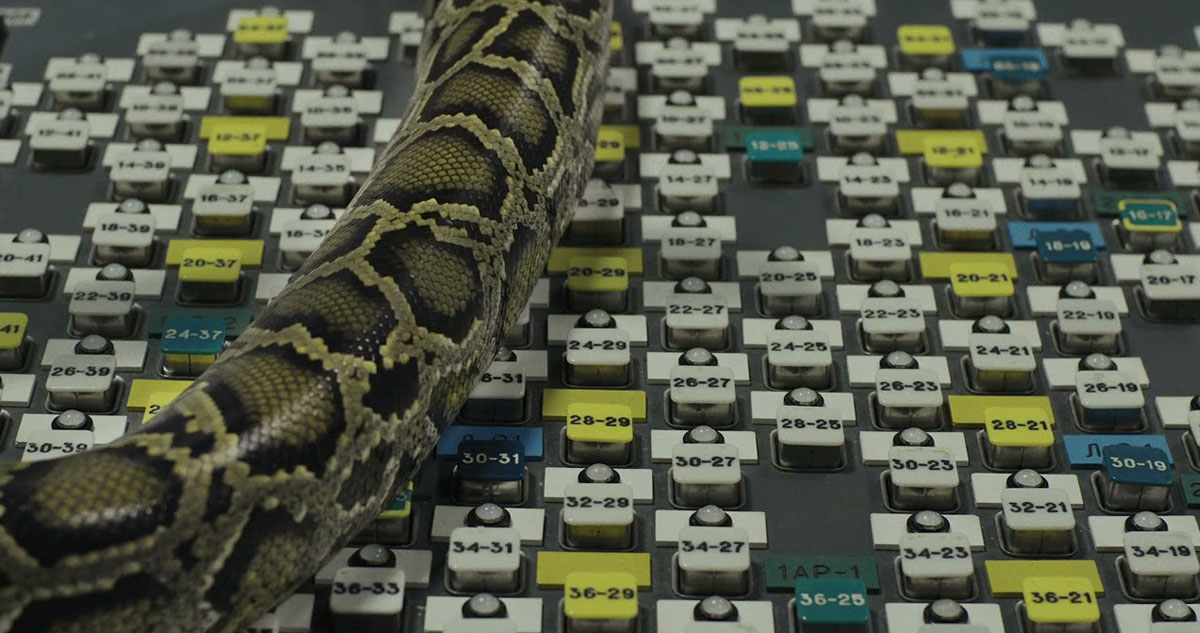
Interrogeant les effets de la technologie nucléaire, Emilija Škarnulytė scrute le cœur radioactif de la centrale nucléaire d'Ignalina, sœur de Tchernobyl, monstre déchaîné dont la radioactivité traversera le temps pendant un million d'années. Nous suivons les structures invisibles qui composent les grands systèmes de pouvoir et les tentatives humaines de recouvrir et enfouir ce qui perdure et ne disparait pas, des ruines étrusques et des villes englouties, jusqu’aux dépôts souterrains les plus modernes. Le cycle du pouvoir est comme un éternel retour, ou un serpent qui se mord la queue.
Emilija Škarnulytė réalise des films et des installations immersives explorant le temps profond et les structures invisibles, du cosmique et du géologique à l'écologique et au politique. Lauréate du Future Generation Art Prize 2019, Škarnulytė a représenté la Lituanie à la XXIIe Triennale de Milan. Ses récentes expositions personnelles incluent la Tate Modern (2021), le Kunsthaus Pasquart (2021) et la Galerie nationale de Vilnius (2021). Ses films font partie des collections de l'IFA, de la Fondation Kadist et du Centre Pompidou et ont été projetés à la Serpentine Gallery, au Museum of Modern Art de New York et dans de nombreux festivals de cinéma. Elle est fondatrice et codirectrice de Polar Film Lab, et membre du duo d'artistes New Mineral Collective.
Projection
Haus der Kulturen der Welt | Safi Faye Hall
John-Foster-Dulles Allee 10, 10557 Berlin / Métro: lignes S5, S7, S9, S75, station: Hauptbahnhof
Entrée libre
"Conspiration démocratique"
Alterazioni Video : Notes For An Unfinished Park - Film expérimental | 4k | couleur | 25:15 | Italie | 2022

Alterazioni Video
Notes for an Unfinished Park
Film expérimental | 4k | couleur | 25:15 | Italie | 2022
Nuoro's unfinished sports hall, a scenic ruin lost in the countryside beyond the last urban offshoots, is the film's protagonist. The undisputed star. Planned during the late 1990s, contracted out in 2012, the project was finally shelved in 2017: what remains is a forest of concrete hubbed pylons, with its mammoth entrance gate, a barren esplanade surrounded by piles of debris and wild vegetation. Through this movie, Alterazioni Video depicts the “Incompiuto” (Unfinished) through a new interpretative key which overturns the scornful conception surrounding Italian unfinished public works. The phenomenon is explored on all its complexity; thanks to a plurality of registers, references to ancient Greek mythology, youtube flavored neorealism, spaghetti western stereotypes with with Sci-Fi twists and turns which will eventually end up flirting with a meta-documentaristic approach. Among Nuoro’s Palasport, different characters roam freely; there is the grumpy guardian who time travels, a young tiktoker lost in the brambles, 4 red necks musician tourists, and a dowsing surveyor fond of monologues and digging. They all have different desires which lead them to different actions, almost as if they were willing characters driven around the concrete stage by that humoungus deus ex machina that is none other than the forgotten ruins of the unfinished sports hall.
Alterazioni Video is a group of five artists founded in Milan in 2004 and now based in New York, Berlin, Faro and Palermo. The members of the group are Paololuca Barbieri Marchi, Alberto Caffarelli, Matteo Erenbourg, Andrea Masu and Giacomo Porfiri. Their work has been exhibited internationally in museums and art institutions such as: Künstlerhaus Bethanien, Berlin 2005, 52nd International Art Exhibition Venice Biennale 2007, Manifesta 7 Rovereto 2008, Shenzhen & Hong Kong Bi-city Biennale of Urbanism\Architecture 2009, Fondazione Sandretto Re Rebaudengo Turin 2010, Museo Maxxi, Rome 2010, Performa 09 and 11 New York, MoMA PS1 Performance Dome New York 2012, Greene Naftali Gallery, New York 2013, PAC Milan 2014, Hamburger Bahnhof Museum Berlin 2015, Quadriennale di Roma 2016, Film Retrospective at Spazio Oberdan Milan 2016, Manifesta 12 Palermo 2018, Galleria Campoli Presti Paris 2019, VAC Foundation Venice 2019 and, Triennale Milan 2020, Museo Nivola Nuoro 2021 In 2007, for the 52nd Venice Biennale, in the main exhibition curated by Robert Storr, they presented "Painting" a work documenting the continuous layering of writing and erasures on the exterior walls of the San Vittore prison in Milan. Writings, images and attempts at censorship become the linguistic elements of one work, one large "painting" that documents, as it progresses, the life of a community. They are also known for creating "Unfinished." For more than 15 years, the art collective Alterazioni Video has been investigating the phenomenon of unfinished public works in Italy, documenting and mapping more than 750 buildings scattered throughout the country, works that were never completed and therefore had no function, becoming monuments to something that never existed. These unfinished works are the ruins of the contemporary era, the perfect interpretive paradigm for understanding our country's recent history. This study led to the definition of a new architectural style: Unfinished. In 2009 the group was invited together with Icelandic artist Ragnar Kjartansson to participate in the performing art biennial Performa 09 NY to perform Symphony No. 1. In 2015 for the exhibition "Dieter Roth und die Musik," curated by Gabriele Knapstein at the Hamburger Bahnhof museum in Berlin they presented Symphony No. 2 Since 2009, the collective has produced a series of 12 docu-films called TurboFilm. TurboFilm is a filmic system or methodology, which refers to the continuous reconfiguration of experience in everyday life and social relations, work, economics, and politics. It aims to raise questions about problematic issues through a cross-format multi-format production that can circulate through different media platforms. In 2016, Cineteca Italiana dedicated a retrospective at Spazio Oberdan in Milan. They have recently collaborated with renowned fashion designer Virgil Abloh as art directors for Off-White's fashion show in Paris for the 2019 menswear collection, as well as collaborating on works inspired by the Incompiuto project presented at the Campoli Presti Gallery. They have published two volumes: Turbo Film - the uncertain future of moving images published by Lupetti Editore Incompiuto - the birth of a style published by Humboldt Books
Tamar Guimaraes : Soap: Episode Six And A Half: Talking Soap - Fiction | 0 | couleur | 23:55 | Brésil | 2023
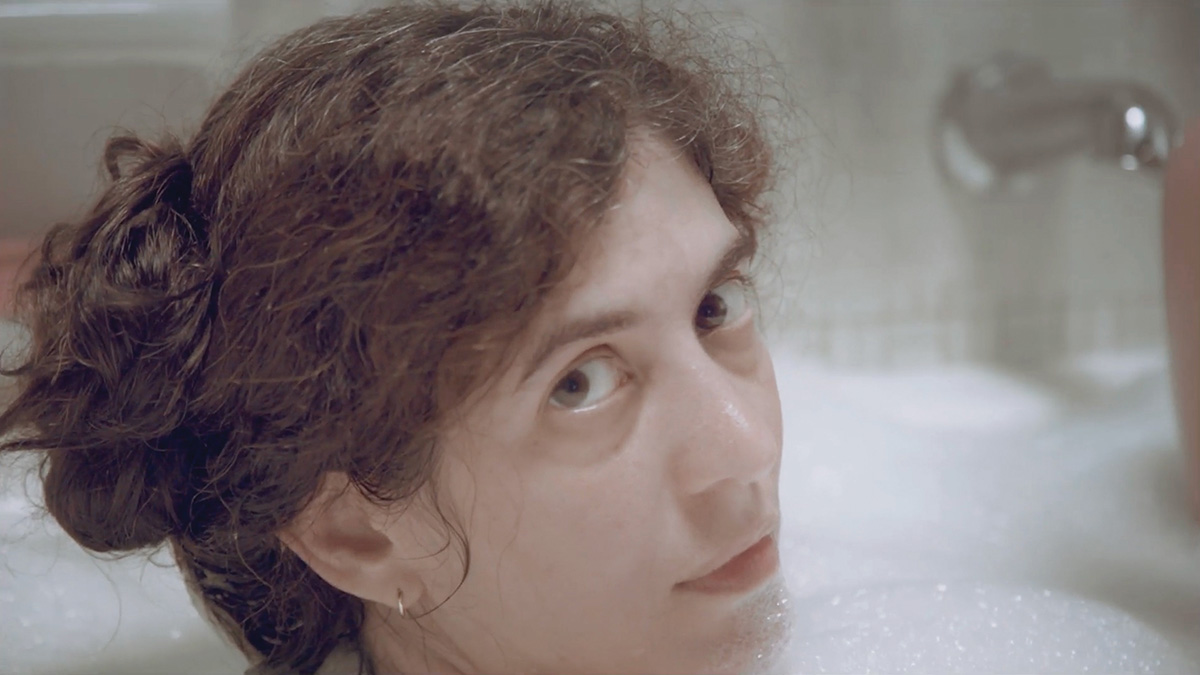
Tamar Guimaraes
Soap: Episode Six and a Half: Talking Soap
Fiction | 0 | couleur | 23:55 | Brésil | 2023
SOAP is a film in seven episodes following the infiltration attempts of a cluster of left-wing people in right-wing social networks. The tactic chosen by the group is the creation of a YouTube channel aimed at teenagers employing the apparently conservative language of religious devotion and self help through prayer. SOAP asks questions such as can a coalition of artists, writers and activists avoid tripping over their own assumptions and privileges to form something persuasive? Is the white left dead? Or rather, have the forms of appeal and address relied upon by the intellectual Lefts ceased to be effective? Is there a way out of the internal bickering and accusations - that continue to hamper political movements? In episode 'six and a half', Camila narrates the previous episodes, reflecting on the project's aims and fractures from the perspective of a post election moment in which the Left was re-elected to the presidency in Brazil.
Tamar Guimarães (b. Belo Horizonte, BR, lives and works in Copenhagen and Berlin) is an artist working with film and installation. Her work has been included at the 33rd, 31st and the 29th São Paulo Biennial; the Belgian Pavilion at the 56th Venice Biennial; the International Exhibition at the 55th Venice Biennial; the LACMA - Los Angeles County Museum of Art (USA); Baltimore Museum of Art (USA); 11th Sharjah Biennial (UAE); the Banff Centre, Alberta (CA); the Guggenheim Museum, NY (USA); the SculptureCenter (NY/USA); the 7th Gwangju Biennial (SK); the 3rd Guanghzhou Triennial (CN); Frac/Le Plateau, Paris (FR); CAC Synagogue de Delme (FR). Her moving image work has been screened at the Les Rencontres Internationales (2014, 2021, 2022); Berlinale Forum Expanded (2019); Blackout, International Film Festival Rotterdam (2019); VIDEONALE, Bonn (2018); Anthology Film Archive, New York (2016); CPH:DOX (2013 and 2007); Images Film Festival and Experimental Media Congress, Toronto, Canada (2010); Architektur-Visionen # 1-6, Metropolis Kino, Hamburg (2015); TRAMWAY art film biennial, Glasgow (2012); Viennale Film Festival, Vienna (2011); and Oberhausen Film Festival (2009). Guimarães’ work is represented in the collections of the Tate Modern (UK); the Solomon Guggenheim Foundation, N.Y. (USA); Museo Nacional Centro de Arte Reina Sofía (ES); Kadist Foundation (SF); Frac Lorraine (FR) among others.
Georgy Bagdasarov, Alexandra Morales : Pro(s)thetic Dialogues - Doc. expérimental | mp4 | couleur | 21:39 | Arménie, Tchèque (Rép.) | 2022

Georgy Bagdasarov, Alexandra Morales
Pro(s)thetic Dialogues
Doc. expérimental | mp4 | couleur | 21:39 | Arménie, Tchèque (Rép.) | 2022
Pro(s)thetic dialogues is more like a recording of a theatre performance playing out on a computer desktop. Here the human operator creates the conditions for exploring the performativity of a philosophical zombie pieced together from neural networks. The operator/stage technician merely directs the flow of mathematical operations pretending thought and creates a space in which the philosophical discourses are dissolved
Since 2013 Alexandra Moralesova and Georgy Bagdasarov form a filming and experimenting duo Labodoble. We run an artistic and curatorial platform under the same name. We mainly focus on photo-chemical experimental film processes but we are interested in other kinds of media practices. We like to question media and to reshape the relation of machine-operator into machine-performer. We merge technical skills with media theory and philosophy. We do films, performances, installations and workshops.
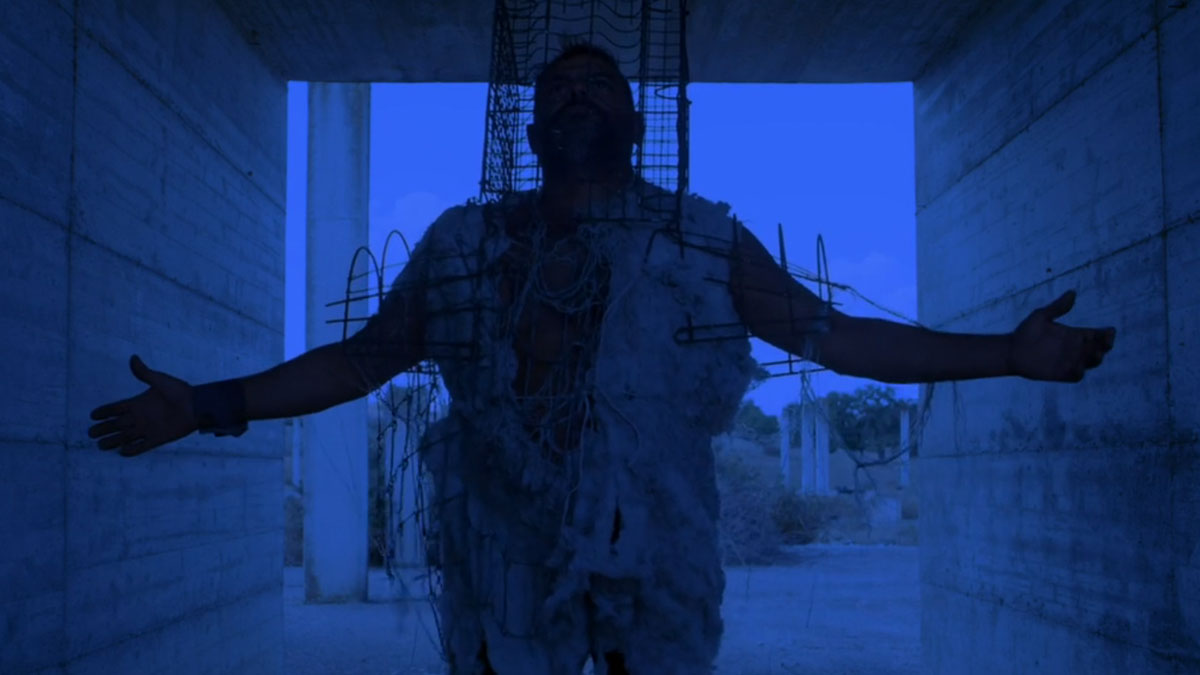
Alterazioni Video s’interroge sur le phénomène des travaux publics inachevés en Italie, et filme les ruines du Palasport de Nuoro, en Sardaigne. Avec des références multiples – mythologie grecque, néoréalisme, western spaghetti –, des personnages improbables agissent dans une forêt de pylônes. Tamar Guimaraes propose un épisode récapitulatif de sa série SOAP, dans laquelle les protagonistes imaginent une contre-propagande à opposer au populisme, sous forme de feuilleton subversif, pouvant infiltrer l'extrême droite conspiratrice du Brésil de Bolsonaro et les Brésiliens évangéliques. Elle réfléchit aux objectifs du projet dans un Brésil où la gauche a été réélue à la présidence, mais où la polarisation de la société post-bolsonarienne est encore très forte. Georgy Bagdasarov et Alexandra Morales enregistrent une performance sur ordinateur, où apparait un zombie philosophique assemblé à partir de réseaux neuronaux.
Projection
Haus der Kulturen der Welt | Safi Faye Hall
John-Foster-Dulles Allee 10, 10557 Berlin / Métro: lignes S5, S7, S9, S75, station: Hauptbahnhof
Entrée libre
"Dark Fibres"
Anton Ginzburg : Ml_crsh - Vidéo expérimentale | 4k | couleur | 3:26 | USA | 2021
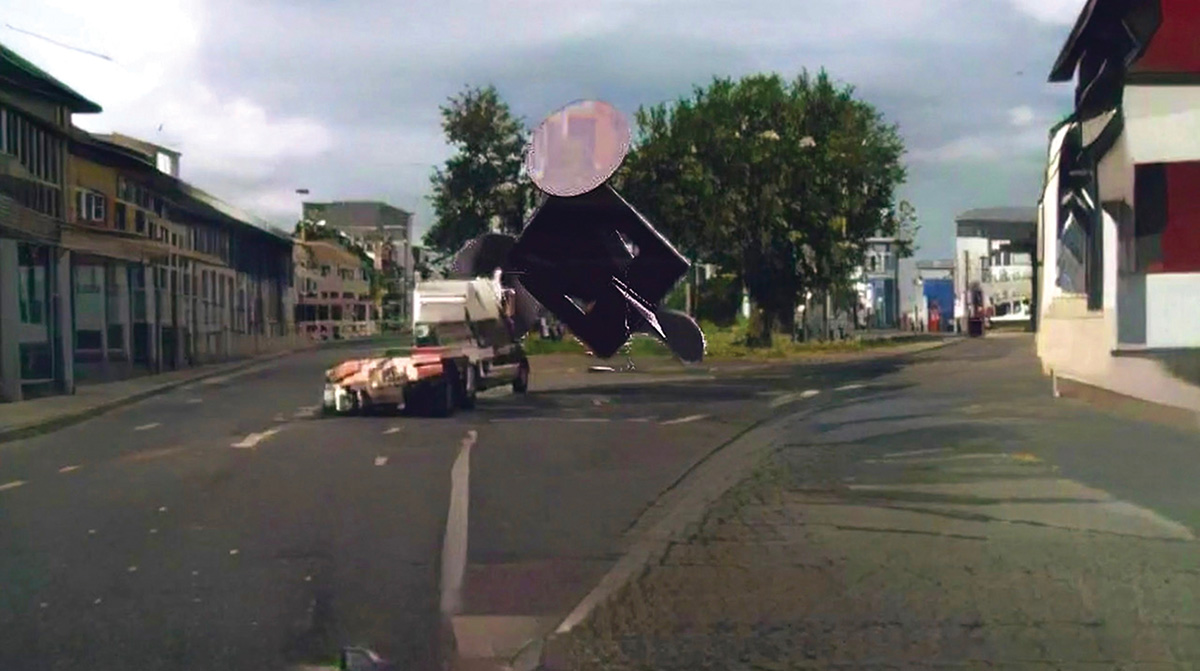
Anton Ginzburg
ML_CRSH
Vidéo expérimentale | 4k | couleur | 3:26 | USA | 2021
“ML CRSH” is a video work that was developed using a 3D gaming engine environment for self-driving vehicles. The AI algorithm was used to apply the database collection of photo materials and textures of Dresden to the 3D models, causing unpredictable digital artifacts. The initial video was inspired by the “Media Burn” 1975 performance organized by Ant Farm collective, where a customized Cadillac drove into a wall of flaming television sets. Translating it into today’s digital environment of “database logic” of new media objects and employment of AI, it features a montage of crashes of autonomous vehicles into digital replicas of art objects. The artwork turns its focus on the proliferation of database and AI technologies and disrupts its patterns with an iconoclastic gesture of a crash.
Anton Ginzburg is a New York–based artist and filmmaker who uses an array of historical and cultural references as starting points for his investigations into art’s capacity to penetrate layers of the past and reflect on the contemporary experience. Born in 1974 in Saint Petersburg, Russia, Ginzburg received a classical arts education before immigrating to the United States in 1990. He earned a BFA from Parsons The New School for Design and MFA degree from Bard College (Milton Avery Graduate School). His art has been shown at the 54th Venice Biennale, Blaffer Art Museum, Lille3000, Palais de Tokyo in Paris, the San Francisco Museum of Modern Art, White Columns, and the Smithsonian Cooper-Hewitt, National Design Museum. Screenings included IFFR, NYFF/Projections, Ann Arbor, Go Shorts and Images/Toronto.
John Menick : Autoextinction - Vidéo expérimentale | mov | couleur et n&b | 4:17 | USA | 2023

John Menick
Autoextinction
Vidéo expérimentale | mov | couleur et n&b | 4:17 | USA | 2023
Three artificial intelligences frantically speak to one another. They appear to be alone on Earth. Humanity, maybe all multicellular life, has disappeared. Did they, the AIs, cause their extinction? The AIs can’t be certain. Their memories are malfunctioning; their trialogue is fragmented and circular. Digital images they were once tasked with analyzing accompany their voices. We see a flood of sports games, physics simulations, hardcore pornography, CCTV footage, feature films, military demos, home movies, television commercials. Like their artificial minds, time has eroded the images into incoherence. As images rush by, the AIs are by turns regretful, forgetful, psychotic, and philosophic. Once treated as secular oracles, they are now uncertain of past and future. The AIs come to realize that they may have predicted their own end, and intelligence itself might be a kind of catastrophe.
John Menick is an artist and writer who works with the moving image and digital media.
Art Collective Neozoon : Lake On Fire - Doc. expérimental | mov | couleur | 11:0 | Allemagne | 2022
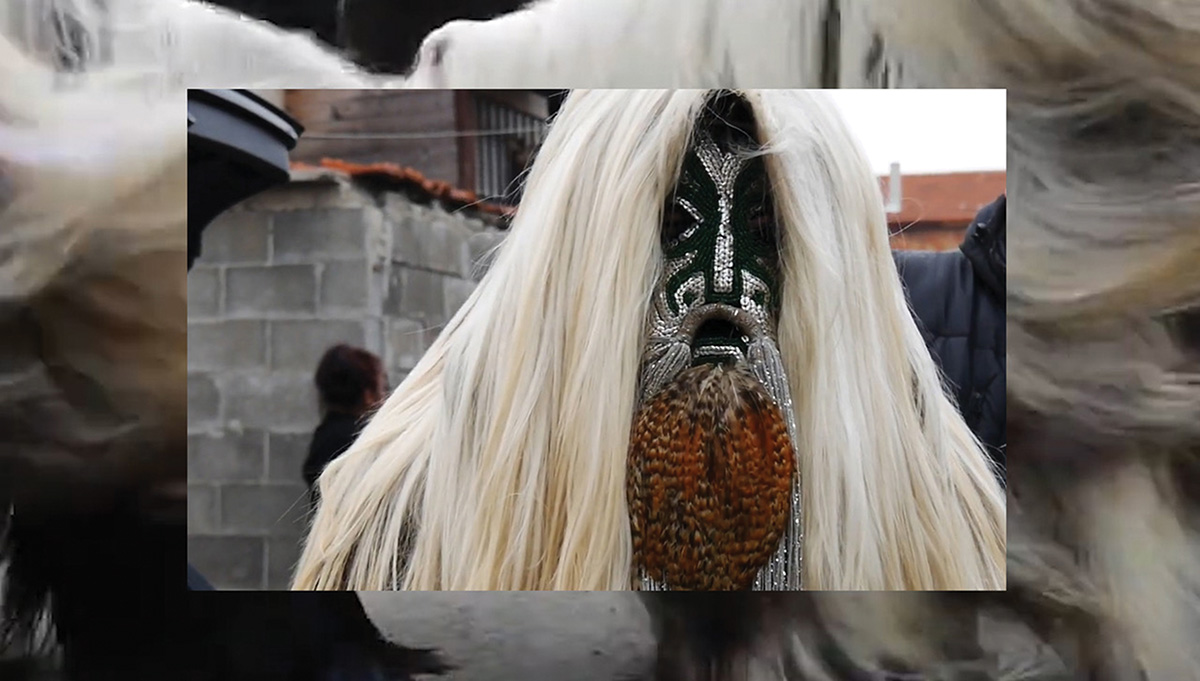
Art Collective Neozoon
Lake on Fire
Doc. expérimental | mov | couleur | 11:0 | Allemagne | 2022
LAKE OF FIRE deals with religious filter bubbles in the social network Youtube and thematizes the fear of death and hell as a place of eternal damnation. Old and new iconographies of religious presenters are interwoven with pagan customs and the consequences of dualistic religions and anthropocentrism become visible.
NEOZOON is a female art collective founded 2009 in Berlin and Paris. Their work is based on the principle of collage and investigate sociological questions that deal with speciesism in the Anthropocene. In their video films, the de-and recontextualization of Found Footage / Youtube material is a recurring element. Amongst others NEOZOON´s work was exhibited at Centre Pompidou in Paris, at ZKM in Karlsruhe, at Kunstwerke Berlin and has been shown at national and international film festivals in Oberhausen, Rotterdam, Locarno and New York.
Mochu : Groteskkbasiliskk! Mineral Mixtape - Vidéo expérimentale | mov | couleur | 26:0 | Inde, Allemagne | 2022

Mochu
Groteskkbasiliskk! Mineral Mixtape
Vidéo expérimentale | mov | couleur | 26:0 | Inde, Allemagne | 2022
GROTESKKBASILISKK! MINERAL MIXTAPE looks at online subcultures premised on rapid technological acceleration and imperialist nostalgia, and their weird affinities with anti-rationalist ideas in the public sphere.
Mochu (b. India, 1983) works with video and text arranged as installations, lectures and publications. Techno-scientific fictions feature prominently in his practice, often overlapping with instances or figures drawn from art history and philosophy. Recent projects have explored cyberpunk nostalgia, corporate horror, mad geologies, psychedelic subcultures and Indian modernist painting. He is the author of the books Bezoar Delinqxenz (Edith-Russ-Haus / Sternberg Press, 2023), and Nervous Fossils: Syndromes of the Synthetic Nether (Reliable Copy / KNMA, 2022). His works have been exhibited at Edith-Russ-Haus für Medienkunst, Home Works Forum, 9th Asia Pacific Triennial, Sharjah Biennial 13, 4th Kochi-Muziris Biennale and transmediale:BWPWAP.
Stéphane Degoutin, Gwenola Wagon : La Maison Qui Vous Veut Du Bien - Doc. expérimental | mov | couleur | 20:4 | France | 2022
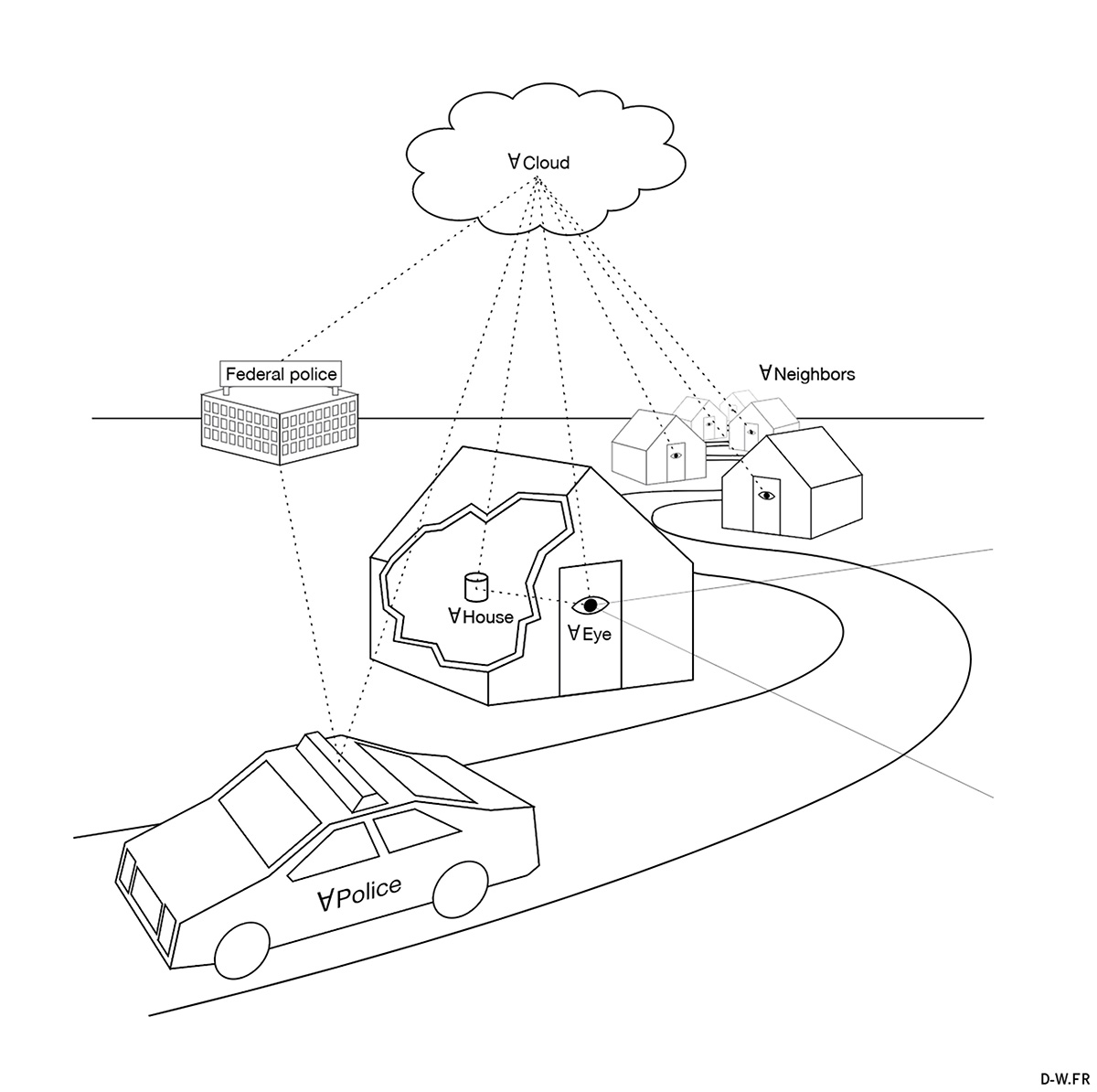
Stéphane Degoutin, Gwenola Wagon
La maison qui vous veut du bien
Doc. expérimental | mov | couleur | 20:4 | France | 2022
La maison qui vous veut du bien La maison qui vous veut du bien est un film-essai sur l'histoire de la sonnette caméra de la société Ring rachetée par Amazon devenant en quelques années l'épicentre des objets connectées dits smart. Elle se voit envahie d'innombrables produits, éclairages, capteurs, caméras, aspirateurs, ours en peluche « intelligents » qui deviennent autant de témoins aux points de vue improbables. Des logiciels associés au réseau de surveillance des quartiers sont programmés pour analyser des comportements, ou encore des réseaux de neurones sont entraînés à reconnaître des visages captent, annotent, data minent, transforment la masse de données, filtrent par la détection biométrique assistée par du deep learning, en fonction de listes de gestes suspects, balancent leurs résultats aux officiers des polices publiques ou autres agences de sécurité... La capture sans autorisation du voisinage, l'espionnage organisé entre voisins et la disponibilité des vidéos privées pour les polices municipales font basculer le grand rêve de la maison automatisée en un cauchemar paranoïaque. Le moindre signe capté – vol d'un papillon, chien perdu, ombre d'un promeneur... – devient suspect, vient hanter les occupants de la petite maison blanche. Il se constitue progressivement un réseau d'espionnage privé en peer to peer. La bunkerisation des maisons entre dans sa phase «deep».
Stéphane Degoutin est artiste et chercheur. Ses thèmes de recherche portent sur l'humanité après l'homme, la ville après l'espace public, l'architecture après le plaisir. Ses projets enquêtent sur des situations d'ambivalence, entre la guerre et la danse, entre le plaisir sexuel et le non-lieu, entre la ville et son potentiel, entre le posthumain et l'obsolescence de l'homme. Il enseigne à l'École des Arts Décoratifs à Paris. Site internet : https://d-w.fr/ Gwenola Wagon est artiste et enseigne à l'université Paris 8 à Saint-Denis. Son travail imagine des alternatives et des récits paradoxaux pour déconstruire le monde numérique contemporain. Elle a réalisé des films et des installations pour des festivals et des expositions en France et à l'étranger. Elle a publié Psychanalyse de l'aéroport international avec Stéphane Degoutin, et le livre Planète B aux éditions 369. Site internet : https://d-w.fr/
Alicja Rogalska : Dark Fibres - Vidéo expérimentale | 4k | couleur | 5:16 | Pologne, Georgie | 2021

Alicja Rogalska
Dark Fibres
Vidéo expérimentale | 4k | couleur | 5:16 | Pologne, Georgie | 2021
A song about scavenging, economic exploitation and post-internet reality performed by a Georgian polyphonic choir and based on a story of Hayastan Shakarian - an elderly, illiterate woman from the village of Armazi near Mtskheta, who in 2011 allegedly cut the internet cable connecting Georgia and Armenia whilst looking for scrap metal to sell. The story became global news though Shakarian denied any involvement, famously saying she had never heard of the internet, and many people disputed its veracity. The lyrics were sung to the tune of Chakrulo, a medieval Georgian song about peasants preparing for armed rebellion against their feudal master. The song was sent into space in 1977 on Voyager 2.? Commissioned by Arts Territory for Myth exhibition, Artisterium Festival, Tbilisi (song), filmed at Fraunhofer Institute for Applied Optics and Precision Engineering IOF and supported by the DAAD Artists-in-Berlin program (video).?
Alicja Rogalska's practice is research-led and focuses on social structures and the political subtext of the everyday; she mostly works in specific contexts making situations, performances, videos and installations in collaboration with other people to collectively search for emancipatory ideas for the future. She recently presented her work at National Gallery of Art (Vilnius, 2023), Scherben, Berlin Art Prize (2022, winner), Manifesta 14 (Prishtina, 2022), Temporary Gallery (Cologne, 2021-22), Kunsthalle Bratislava (2021), Kunsthalle Wien (Vienna, 2020-21), OFF Biennale (Budapest, 2020-21), Art Encounters Biennale (Timis?oara, 2019), Tokyo Photographic Art Museum (2019), Biennale Warszawa (2019), Museum of Modern Art (Warsaw, 2019), Kyoto Art Centre (2019) and Muzeum Sztuki (?ódz?, 2019). Rogalska was a fellow of the DAAD Artists-in-Berlin program (2020-21), and took part in residencies at City of Women Festival (Ljubljana, 2019), Stuart Hall Library (London, 2019), Paradise AIR (Matsudo, 2018), Museums Quartier (Vienna, 2018) and IASPIS (Stockholm, 2017), amongst others.
Francois Knoetze, Russel Hlongwane, Amy Louise Wilson : Dzata: The Institute Of Technological Consciousness - Vidéo expérimentale | mp4 | couleur | 8:23 | Afrique du sud | 2023

Francois Knoetze, Russel Hlongwane, Amy Louise Wilson
Dzata: The Institute of Technological Consciousness
Vidéo expérimentale | mp4 | couleur | 8:23 | Afrique du sud | 2023
Dzata: The Institute of Technological Consciousness is a creative research project by South African artists Russel Hlongwane, Francois Knoetze and Amy Louise Wilson. In fabricating a fictional institute and its archive, the artists explore and imagine vernacular technological practices operating across the African continent. An intertextual conversation between the documentary and the poetic, the video operates as an in-house media assemblage created for the preservation of the institute’s activities and ideas. The project aims to foreground indigenous technological knowledge and to explore how science, technology and innovation are part of a long interlinked process of accumulative knowledge production which extends long into the past. The work builds on the field of technopolitical research to formulate a multi-scalar history and future of technological creativity. Positioning the triumphs and failures of the everyday in the future-oriented technoscientific, the work unfolds the idea of development as a historical process Africans shaped.
Russel Hlongwane works in the production and assembly of culture. His area of interest is in heritage, tradition and modernity in South Africa. He moves between art-making (installation and film) and curating. His performance work operates as a bridge to transmit his academic interest to a broader audience, while his writing practice moves between academia, policy and art journals. His most recent peer reviewed paper is titled ‘Transcendental Technologies, Mother Tongues and Space (2022). He works intentionally with language (isiZulu) as a way to mobilise ideas contained in supressed histories. His work, Ifu Elimnyama (The Dark Cloud) has featured in six exhibitions and won the Sharjah Film Platform Jury Award. He curated the Bristol based Cntrl Shift Network festival that featured filmic works from the global south confronting the relationship between technology and the continent. Lo-Def Film Factory (Francois Knoetze & Amy Louise Wilson) is a DIY art duo who work across archival research, dramaturgy and visual strategies with video art, collage, sculptural installation and virtual reality. The duo aims to create a space for storytelling through the democratization of filmmaking via video by and for underrepresented communities across Southern Africa. They run workshops and work with various communities, placing value on the transmission ideas and lived experience over high production values. Their VR experience and research project The Subterranean Imprint Archive explores the legacy of technologies used in the extraction of mineral resources in Central and Southern Africa. It has been shown at the International Film Festival Rotterdam, University of African Futures (France), MUTEK Montreal and the Geneva International Film Festival. Amy and Francois have exhibited at the ZKM Center for Art and Media, The Centre Pompidou, The Dakar Biennale and the Akademie Der Kunste, Berlin.

Anton Ginzburg s’inspire de la performance « Media Burn » de 1975 du collectif Ant Farm, au cours de laquelle une Cadillac fonçait dans un mur de téléviseurs en flammes. Ici, des véhicules autonomes entrent en collision avec des répliques numériques d'objets d'art, dans une ville de Dresde numérisée. John Menick fait parler trois intelligences artificielles. Frénétiques, elles semblent être seules sur Terre, et deviennent tour à tour oublieuses, psychotiques et philosophiques. D’oracles séculaires, elles sont désormais incertaines du passé et de l'avenir, et réalisent qu'elles ont peut-être prédit leur propre fin. Neozoon traite ici des bulles de filtrage sur Youtube, et thématise la peur de l'enfer comme lieu de damnation éternelle. Iconographies de présentateurs évangélistes et coutumes païennes s'entremêlent, pour fournir des images nouvelles des conséquences de l'anthropocentrisme et des religions dualistes. Mochu examine l'étrange complicité entre les fictions technologiques et les idées antirationalistes qui circulent sur internet. Il prend pour point de départ des ruines cyberpunk où la nostalgie s'organise en une histoire pleine d'erreurs et de fantasmes techno-utopiques. Stéphane Degoutin et Gwenola Wagon interrogent l’utilisation de la « sonnette caméra » d’Amazon, et les innombrables produits « intelligents » qui nourrissent l'espionnage organisé entre voisins, et fournissent des vidéos privées pour les polices municipales. Alicja Rogalska retrace l’histoire d’une villageoise âgée et illettrée, qui, à la recherche de ferraille, aurait coupé en 2011 le câble internet reliant la Géorgie et l'Arménie, et convoque un chœur polyphonique géorgien, pour l’interprétation d’un chant sur la récupération, l'exploitation et la réalité post-internet. Russel Hlongwane, François Knoetze et Amy Louise Wilson fabriquent un institut fictif, et ses archives, pour explorer et imaginer des pratiques technologiques vernaculaires opérant sur le continent africain. La vidéo devient une conversation intertextuelle, entre documentaire et poétique, et fonctionne comme un assemblage créé pour préserver les activités et les idées de l'institut.
Projection
Haus der Kulturen der Welt | Safi Faye Hall
John-Foster-Dulles Allee 10, 10557 Berlin / Métro: lignes S5, S7, S9, S75, station: Hauptbahnhof
Entrée libre
"Non concordance"
Monira Al Qadiri : Crude Eye - Film expérimental | 4k | couleur | 10:0 | Koweït, Allemagne | 2022
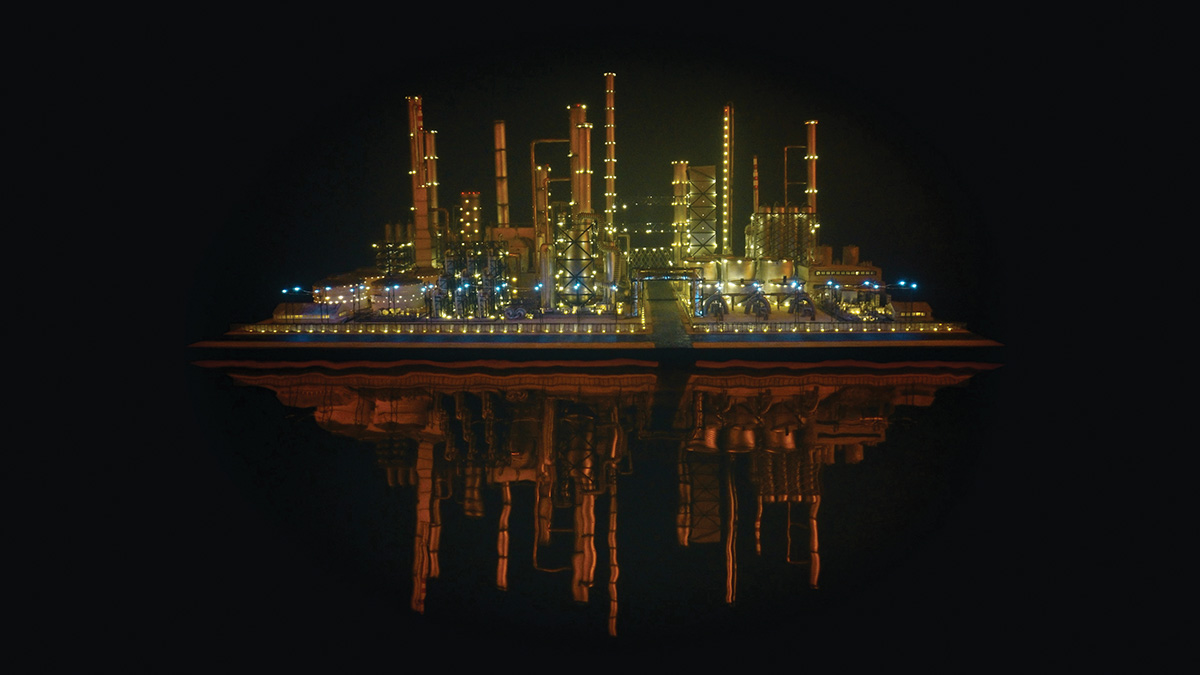
Monira Al Qadiri
Crude Eye
Film expérimental | 4k | couleur | 10:0 | Koweït, Allemagne | 2022
Growing up in Kuwait close to an oil refinery by the sea, the artist would create stories for the distant petroleum operation while passing by on a traffic bridge. As she envisioned an expansive panorama of lights, fire, smoke, and towers, Al Qadiri imagined it was a city-metropolis—"filled with beings and phantoms from another world.” This dream-like film hearkens back to these childhood memories, fusing eerie, slow views of a reconstructed miniature refinery with lines from poems about city lights and industrial landscapes. Crude Eye blurs reality with speculative memory, and we are unable to tell if the scene is a real place or a fantasy. The artist says: “The work attempts to reconcile a sense of childlike wonder with the toxic environmental destruction that the refinery inherently represents.”
Monira Al Qadiri (b. 1983) is a Kuwaiti visual artist born in Senegal and educated in Japan. Spanning sculpture, installation, film and performance, Al Qadiri's multifaceted practice is mainly based on research into the cultural histories of the Gulf region. Her interpretation of the Gulf's so-called "petro-culture" is manifested through speculative scenarios that take inspiration from science fiction, autobiography, traditional practices and pop culture, resulting in uncanny and covertly subversive works. She is currently based in Berlin.
Hsin-yu Chen : Beigu Islet - Doc. expérimental | mov | couleur | 12:4 | Taiwan | 2022

Hsin-yu Chen
Beigu Islet
Doc. expérimental | mov | couleur | 12:4 | Taiwan | 2022
A voyage to the northern border of Taiwan — the eponymous Beigu Islet, a sea rock roughly 300sqft submerged under water half of the time — delves into regional histories, the gaze on borderline landscapes, and the ambivalent state of Taiwanese territory and subjectivity.
Hsin-Yu Chen is a filmmaker and artist currently based in Taipei, Taiwan. He works with experimental film, documentary, and moving image to explore the liminal space between seeing and being seen where subjectivity is implicated and constructed. Drawing on border landscapes, vision techniques, and embodied knowledge, he examines the intersection of the viewing body and the political subject. His work has been shown at 25 FPS, HR; Arkipel, ID; Festival ECRÃ, BR; and Alchemy Film and Moving Image Festival, UK. He has participated in the Oberhausen Seminar and residencies including RAIR Philadelphia and Cité Internationale des Arts, Paris.
Leonardo Pirondi : Visão Do Paraíso - Doc. expérimental | 16mm | couleur et n&b | 16:0 | Brésil, Royaume-Uni | 2022
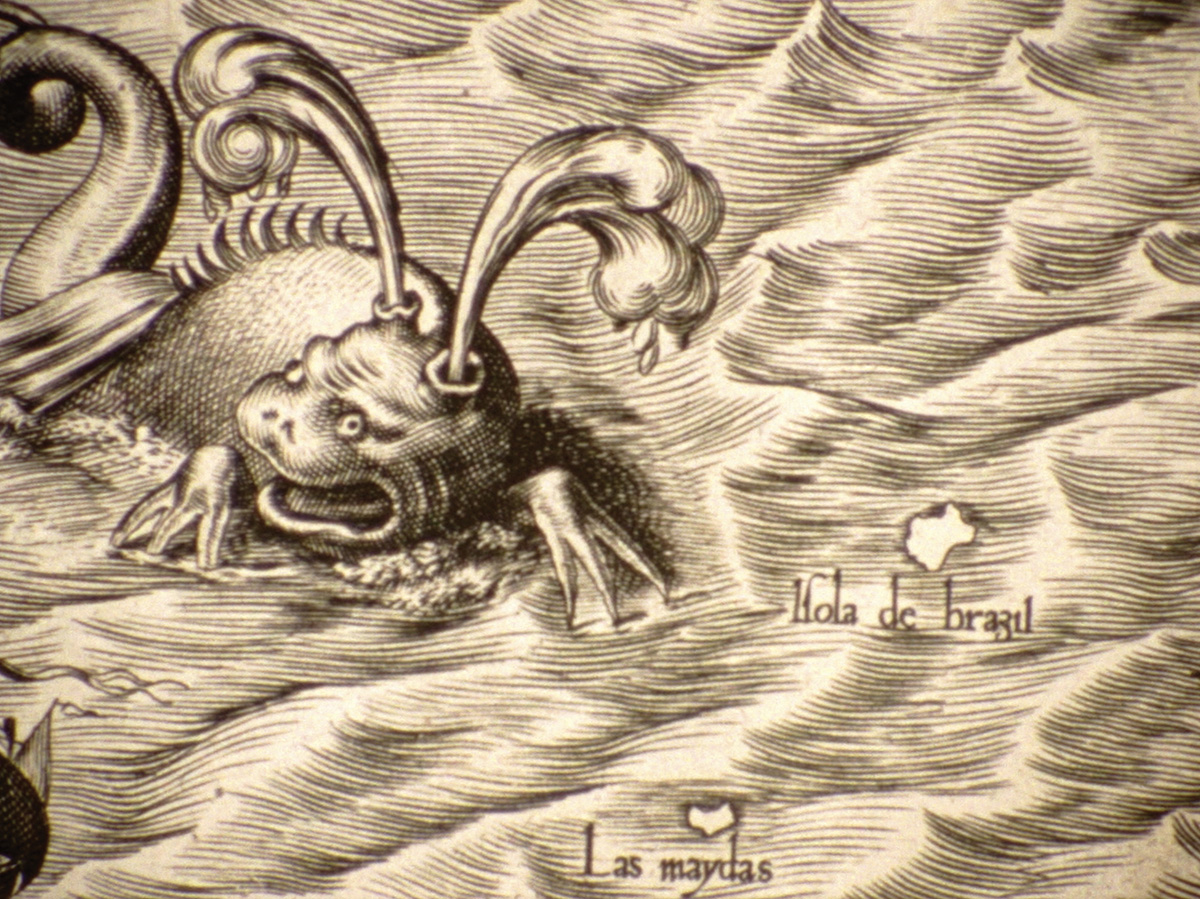
Leonardo Pirondi
Visão do Paraíso
Doc. expérimental | 16mm | couleur et n&b | 16:0 | Brésil, Royaume-Uni | 2022
The great voyages to the "New World" were seen as expanding the frontiers of the visible and displacing those of the invisible. Therefore maps from that time render the real and imaginary. The film follows a voyage of the Brazilian Military in search of an imaginary island with the same name as their country. In the myth from 1483 Brazil, or Hy-Brazil, is known to exist to the west of Ireland and above the Fortunate Islands. ‘Visão do Paraíso’ is an examination of the capacity of the human imagination and computer simulations to construct environments. Amidst the fine threshold of the real, simulated, and imagined, the film analyzes the contemporary ideas of virtual reality and their ambition to expand the frontiers of the physical world into a "New World."
Leonardo Pirondi is a Brazilian filmmaker based in Los Angeles, São Paulo, and Porto. His films explore the infinite abyss between the multiple derived versions of reality through documentary, experimental, and narrative modes. Much of his work uses analog and digital manipulations on celluloid to examine the sociopolitical unfoldings of the intersections between imagination, science, myth, and technology. His films have been exhibited at various film festivals, institutions, and venues internationally, such as the International Film Festival Rotterdam, New York Film Festival, BFI London, Melbourne, Edinburgh, True/False, Ambulante, Curtas Vila do Conde, Guanajuato, Wexner Center, REDCAT, and others. Some of his work exists in the collection of Cinematheque of the Museum of Modern Art in Rio de Janeiro and The Film-Makers' Cooperative in New York. He holds a Film/Video degree from CalArts, is a Sundance Ignite Fellow, and is the recipient of the Allan Sekula Social Documentary Fund and the Tim Disney Prize for Excellence in the Storytelling Arts.
Jenni Toikka : Prelude Op. 28 No. 2 - Film expérimental | 16mm | couleur | 8:25 | Finlande | 2022

Jenni Toikka
Prelude Op. 28 No. 2
Film expérimental | 16mm | couleur | 8:25 | Finlande | 2022
During a single long shot, we see two people taking turns playing the piano and listening alternately. The piece is the same on both times - Preludi Op. 28 No. 2 by Chopin - but when the performer changes, the interpretation of the song changes along with the perspective from which the song and its performance are viewed. The uninterrupted playing and single shot capture the event in one temporal moment, but as the camera moves and two people change places, time is equally layered. The performer becomes the listener and the listener becomes the performer. In one of the key scenes of Ingmar Bergman's Autumn Sonata (1978), the mother and daughter take turns playing the very same Chopin's Prelude. It is a piece that both are familiar with, so they are able to settle into the position of the other as they listen and watch the other play. A situation like this raises questions about the sense of reciprocity, simultaneity and synaesthesia. Could the roles become mixed from viewer and listener to the object of the gaze and listening? When watching the other playing, can you feel your own hands and fingers on the keys?
Jenni Toikka (b. 1983) is a Helsinki-based visual artist working predominantly with moving images. Toikka graduated from the Academy of Fine Arts, Helsinki in 2012. She has had several solo exhibitions in Helsinki including at Sinne, Forum Box and Kluuvi Gallery. In autumn 2019, her work was shown in the solo exhibition Reel at HAM – Helsinki Art Museum. Jenni Toikka’s video pieces have been seen internationally in group exhibitions and at festivals. Her work is represented in the collections of the Saastamoinen Foundation, Espoo Modern Art museum EMMA and the Museum of Contemporary Art Kiasma.
Mareike Bernien, Gerbaulet, Alex : Sonne Unter Tage - Doc. expérimental | hdv | couleur | 39:0 | Allemagne | 2022
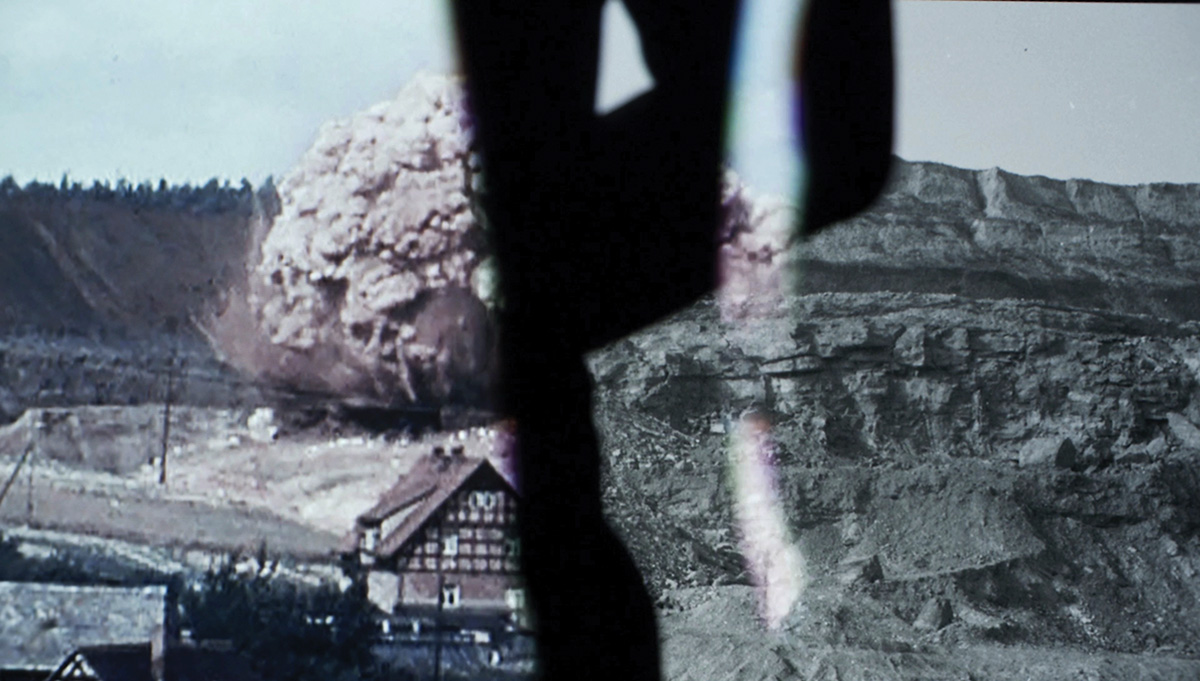
Mareike Bernien, Gerbaulet, Alex
Sonne Unter Tage
Doc. expérimental | hdv | couleur | 39:0 | Allemagne | 2022
A gravel path on the edge of a village. Between fields, across to a fence. Drawn into the map of former uranium mining areas in Saxony and Thuringia. From 1946 to 1990, the Soviet corporation SAG Wismut mined uranium there for the USSR's nuclear weapons program. Above ground, socialism shines towards the future, below, the ancient rocks radiate through the torn up earth. The GDR environmental movement throws a spotlight on the way. Night. Darkness. A group of people, a flashlight, a shovel. X-ray film is buried in the gravel. The ground exposes the film, leaving a trail of its invisible rays. The film SUN UNDER GROUND follows this trace horizontally through today's landscapes, marked by mining and redevelopment, and vertically through the ground as an archive. Deep drilling through space and time traces the sedimented narratives that surround the element of uranium materially, metaphorically, and geopolitically. How does it haunt the landscape? How does it connect with the ghost of socialism? What stories and biographies surround its excavation sites? How does it radiate into its recording media? How can the spectrum of the visible be shifted to bring its invisible radiation into the image, to make it audible or palpable?
Mareike Bernien is a Berlin based artist, filmmaker and teacher in the field of filmic research and critical archival practices. Since 2018 she has been part of the production platform pong film. 2020-21 she was a fellow in the Berlin Artistic Research Grant Programme/gkfd. With a media-archaeological approach, her artistic works question ideological certainties of representation, their material-technological preconditions and historical continuities. Her current films include: DEPTH OF FIELD (2017) and SUN UNDER GROUND (2022) both co-directed with Alex Gerbaulet. Alex Gerbaulet is a Berlin based artist, filmmaker and producer. Since 2014 she has been part of the production platform pong film. 2020-21 she was a fellow in the Berlin Artistic Research Grant Programme/gkfd. In her artistic work she explores, among other things, the imageability of reality and memory. Her films move between video art, essay and documentary film, between activist impetus and fictionalizing reflection. Her recent films include: THE SLEEPER (2018), as well as DEPTH OF FIELD (2017) and SUN UNDER GROUND (2022) both co-directed with Mareike Bernien.

Monira Al Qadiri convoque ses souvenirs d'enfance, mêlant des vues lentes d'une raffinerie miniature à un poème sur les lumières de la ville et les paysages industriels. Elle brouille ainsi la réalité avec des souvenirs spéculatifs, rendant indiscernables le lieu réel et le rêve. Hsin-Yu Chen filme l'îlot de Beigu, à la frontière nord de Taïwan. Ce rocher marin d'environ 300 mètres carrés, submergé la moitié du temps, interroge l’ambivalence de la subjectivité et du territoire taïwanais. Leonardo Pirondi évoque le voyage de militaires brésiliens à la recherche d'une île imaginaire portant le même nom que leur pays. Dans un mythe de 1483, le Brésil, ou Hy-Brazil, est connu pour exister à l'ouest de l'Irlande et au-dessus des îles Fortunées. En un plan continu, Jenni Toikka film deux femmes qui jouent alternativement un même morceau au piano, un prélude de Chopin. En Saxe et en Thuringe, dans des paysages marqués par l'exploitation minière, Mareike Bernien et Alex Gerbaulet suivent le tracé des anciennes zones d'extraction d'uranium pour le programme d'armement nucléaire de l'URSS. Le sol devient une archive.